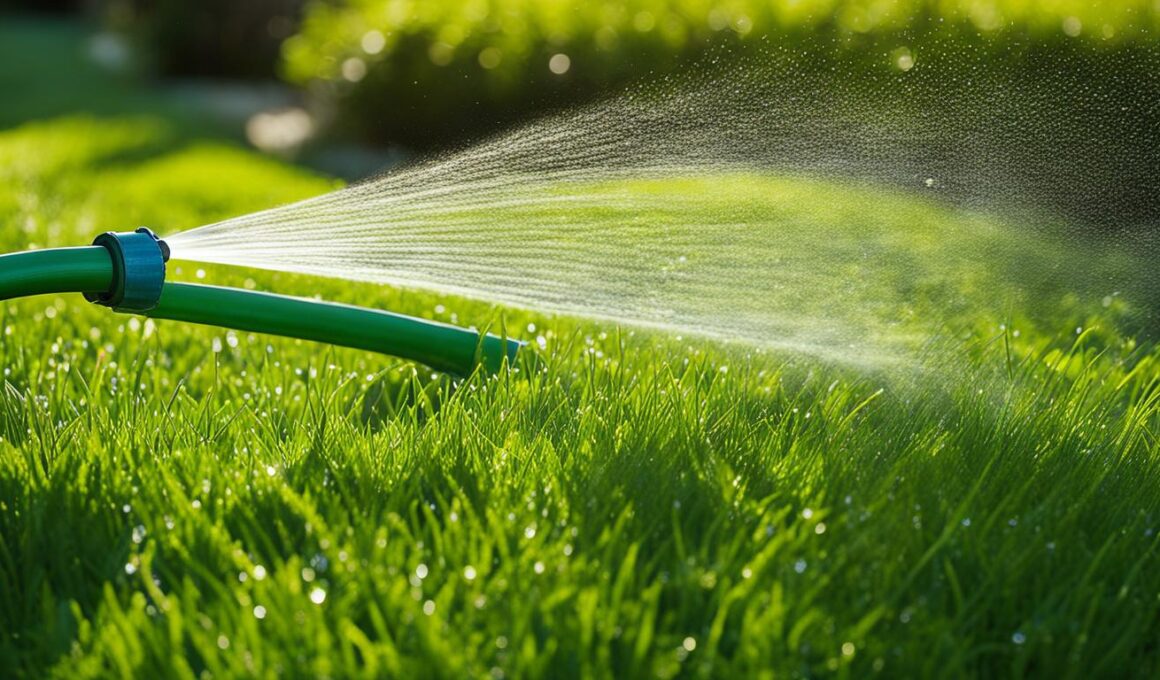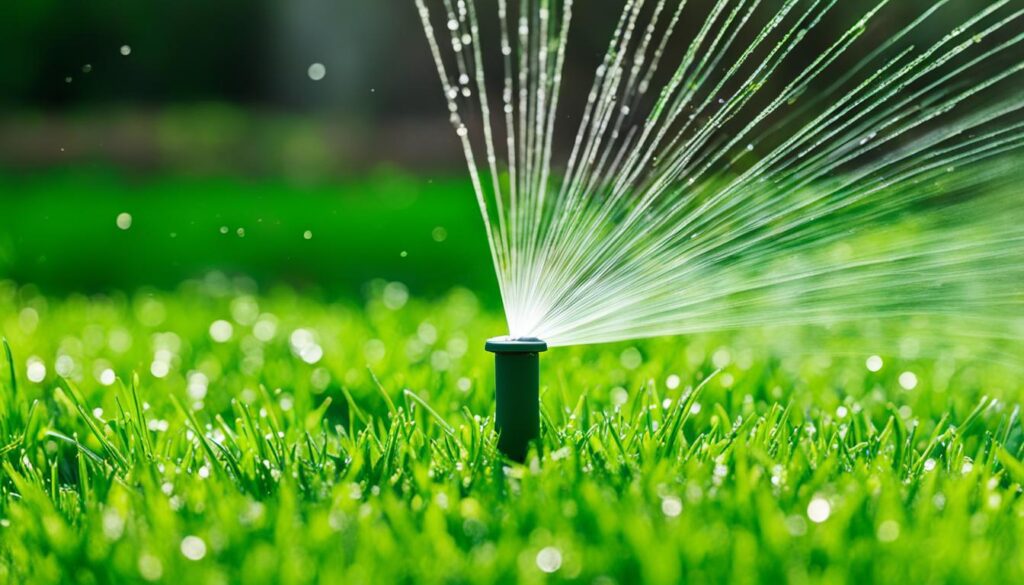Properly watering new grass seed is essential for achieving a healthy and vibrant lawn. The optimal watering duration plays a crucial role in promoting healthy lawn growth. By following the recommended watering guidelines, you can ensure proper root development and avoid damage to the grass.
Watering duration for new grass seed varies at each stage of growth, from germination to maturation. It is important to adjust the watering frequency based on weather conditions and the specific needs of your grass variety.
The best time to water newly seeded grass is in the early morning and late afternoon to reduce evaporation. Avoid watering in the evening to prevent fungal growth. Factors such as climate, soil type, grass variety, and weather conditions also influence the watering frequency.
In the following sections, we will provide detailed watering guidelines for each stage of growth, starting from the first two weeks of germination to the later stages of grass establishment. By following these recommendations, you can ensure that your new grass seed receives the optimal amount of water for healthy and lush lawn growth.
Watering Guidelines for Weeks 1 and 2
During the germination process (weeks 1 and 2), it is crucial to keep the soil moist to promote the growth of new grass seed. Proper watering during this period helps prevent surface drying and encourages germination.
Water the new grass seed for short sessions of 10 to 15 minutes, two to three times per day. This frequent yet brief watering helps maintain consistent moisture in the soil, ensuring optimal conditions for germination.
It is important to avoid overwatering during this stage. Instead, focus on keeping the soil consistently moist without saturating it. Overwatering can lead to issues such as poor root development and increased vulnerability to diseases. By following the recommended short watering sessions, you can prevent excess water accumulation while providing the necessary moisture for the seeds to sprout.
To illustrate, picture a daily routine that involves watering the grass seed in the morning and late afternoon for 10 to 15 minutes each time, ensuring the soil remains moist and conducive to germination.
Remember, the goal is to prevent surface drying and create an environment that supports the growth of healthy grass seedlings. By following these watering guidelines for weeks 1 and 2, you set the stage for a vibrant and resilient lawn in the future.
Watering Guidelines for Weeks 3 and 4
As your grass seedlings enter weeks 3 and 4 of growth, it’s important to adjust the watering duration to promote deeper root development and ensure healthy, vibrant grass. By extending the watering sessions, you allow the water to penetrate deeper into the soil, providing essential hydration for the growing roots.
Aim for 20 to 30-minute watering sessions, two times per day. This longer duration allows the water to reach deeper layers of soil, encouraging the grass roots to grow deeper as well. Deeper root development is vital for the long-term health and resilience of your lawn.
Remember to monitor weather conditions and adjust the watering duration accordingly to prevent under or overwatering. It’s crucial to find the right balance, providing adequate moisture for your grass without saturating the soil.
Following these watering guidelines in weeks 3 and 4 will promote healthy growth and set a strong foundation for your new lawn.
Watering Guidelines for Weeks 5 through 8
By weeks 5 through 8, your newly seeded grass has become more established, but it still requires consistent watering to promote healthy growth. Continuing the proper watering practices will help the grass develop deeper roots and maintain its vibrant appearance.
During this stage, it is recommended to continue watering for 20 to 30 minutes per session. However, it is important to adjust the watering duration based on weather conditions. If the weather is hot and dry, you may need to water for a longer duration to ensure adequate moisture reaches the roots.
Aiming to water every other day is a good guideline to follow during this stage. This frequency provides enough water for the grass to thrive without creating excessive moisture that can lead to disease or overwatering issues. It is crucial to monitor the moisture level of the soil and adjust the watering schedule as needed based on your specific lawn’s requirements and the weather conditions.
Remember, every lawn is unique, and factors such as climate, grass variety, and soil type can influence watering needs. Stay attentive to the visual cues your lawn provides, such as dry or wilted grass blades, to determine if adjustments are needed.
Following these guidelines will help ensure your newly established grass continues to grow healthily and maintain its lush appearance.
Watering Guidelines for Weeks 9 and beyond
Once your lawn reaches the more mature stage of growth, which is usually around weeks 9 and beyond, it’s time to transition to a typical watering schedule. At this point, most grass cultivars require approximately 1 inch of water per week to maintain their health and vitality. To achieve this, aim for three 20-minute watering sessions per week, adjusting them based on the weather conditions.
Monitoring the moisture level in the soil is crucial during this stage. Adjust your watering schedule accordingly to ensure your lawn receives adequate moisture without over or under-watering. Consistency is key, but it’s also important to consider the impact of weather-related factors such as rainfall or drought conditions.
Factors Affecting Watering Frequency
When it comes to watering new grass seed, the frequency of watering is influenced by several factors, including the climate, temperature, soil type, grass variety, and weather conditions. Understanding these factors is essential for maintaining the health and growth of your newly seeded lawn.
Climate plays a significant role in determining the watering needs of new grass. In hotter climates, where temperatures can soar, the soil tends to dry out quickly, requiring more frequent watering to keep the grass hydrated and prevent it from becoming stressed. Conversely, in cooler climates, the soil may retain more moisture, reducing the frequency of watering.
Temperature is another crucial factor that affects watering frequency. Warmer temperatures cause the soil to dry out faster, increasing the grass’s water needs. As temperatures rise, you may need to water more frequently to ensure the soil remains adequately moist for healthy grass growth.
The type of soil in your yard also influences watering frequency. Sandy soil has excellent drainage but doesn’t retain water well, requiring more frequent watering to keep moisture levels consistent. On the other hand, clay soil retains water, often leading to waterlogged conditions if not managed properly. It may need amendments to improve drainage and prevent overwatering. Loam soil, which has a balanced mixture of sand, silt, and clay, provides ideal drainage for gardening and grass seed planting.
The specific grass variety you choose also plays a role in determining watering needs. Different grass types have varying tolerance to drought and moisture levels. Some may require more frequent watering to thrive, while others may be more resilient in arid conditions. Consider the water requirements of the grass variety and choose the one that best suits your soil type and climate.
Lastly, weather conditions, such as rainfall and humidity, directly impact how often you need to water your new grass seed. If your region experiences frequent rainfall or high humidity levels, it may reduce the need for supplemental watering. However, during dry spells or periods of low rainfall, you may need to water more often to compensate for the lack of natural moisture.
To determine the optimal watering frequency for your new grass seed, it’s important to assess the combination of these factors and monitor the moisture level in the soil. Regularly check the soil’s moisture content by inserting your finger or a moisture meter into the ground. If it feels dry, it’s time to water. Using a combination of visual cues, such as the color and texture of the grass, along with these factors, will help you determine the right watering frequency for your lawn.
Should I Water My Grass Seed Even If It’s Dormant?
It is essential to water your grass seed even during its dormant period to ensure its survival and longevity. Proper watering within the grass seed lifespan dormant period is crucial for promoting healthy growth and maintaining a lush, green lawn. Keep the soil consistently moist but not waterlogged to support germination.
Conclusion
Properly watering new grass seed is crucial for achieving a lush and healthy lawn. By following the watering guidelines for each stage of growth, you can promote proper root development and prevent damage to the grass. It’s important to consider factors like climate, temperature, soil type, grass variety, and weather conditions when determining the frequency of watering.
Using the recommended watering duration and adjusting it based on your lawn’s specific needs and conditions will ensure optimal growth. Additionally, implementing proper maintenance practices such as regular mowing, fertilizing, and weed control will contribute to a thriving lawn. Consistency and patience are key in establishing a beautiful and resilient lawn from new grass seed.
Remember that watering is just one component of a comprehensive lawn care routine. Along with watering, be diligent in other maintenance tasks like aerating, overseeding, and dethatching to keep your lawn in top condition. By following proper maintenance practices, you can create an enviable and healthy lawn that will be the envy of your neighbors.











